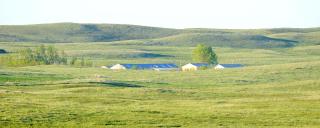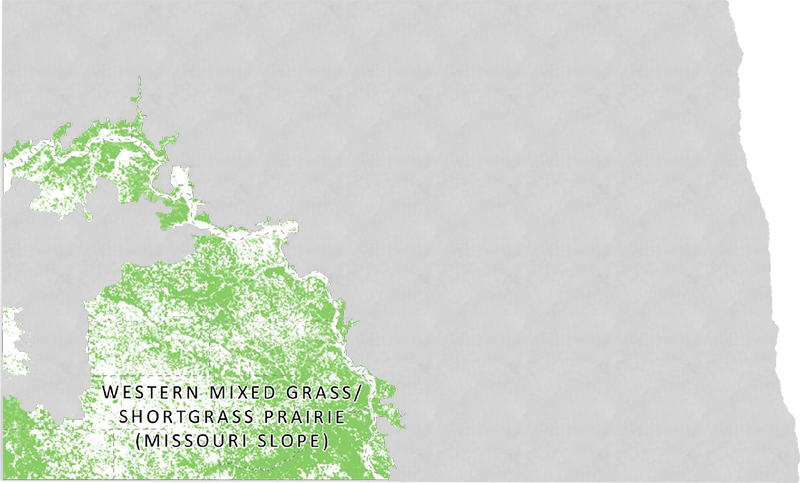
Western Mixed-grass/Short-grass Prairie (Missouri Slope)
Area: 10,768,000 acres or 16,825 mi²
Description and Overall Condition: This landscape component includes the Western mixed-grass prairie and short-grass prairie of the Missouri Slope. This semiarid, unglaciated region of North Dakota includes level to rolling plains topography with isolated sandstone buttes or badlands formations. Natural wetland basins are minimal, probably constituting only several hundred-thousand acres, but small creeks and streams are abundant.
The Badlands of western North Dakota is described as a separate landscape (see Figure 33). The Missouri River System/Breaks is considered by some to be a component of or the boundary between the Missouri Coteau and Missouri Slope, but is described within the Stream, Rivers, and Riparian landscape component (see Figure 24). Shrub-steppe, or prairie that has a large component of sagebrush, occurs scattered throughout. Land use is predominantly dryland farming of spring and winter wheat, barley, sunflowers and corn, interspersed with cattle grazing. However, landcover classifications indicate there is a considerable amount of native vegetation remaining. The oil and gas industry is expanding in the western portion of this region.
Predominant Natural Vegetation
Grasses
blue grama, Western wheatgrass, prairie junegrass, needle-and-thread, needleleaf sedge, buffalo grass, spikemoss, sixweeks fescue, green needlegrass, plains muhly, little bluestem, threadleaf sedge
Forbs
yarrow, gumweed, skeleton weed, purple coneflower, sandlily, white wild onion, death camas, buffalo-bean, purple loco, silverleaf, plains pricklypear, ball cactus, moss phlox, white beardtongue, fringed sage
Associated Species of Conservation Priority
Birds
northern pintail, northern harrier, american kestrel, ferruginous hawk, swainson’s hawk, golden eagle, prairie falcon, sharp-tailed grouse, greater sage-grouse, upland sandpiper, marbled godwit, long-billed curlew, wilson’s phalarope, burrowing owl, short-eared owl, loggerhead shrike, sprague’s pipit, brewer’s sparrow, lark bunting, grasshopper sparrow, baird’s sparrow, chestnut-collared longspur, mccown’s longspur, bobolink, western meadowlark
Mammals
merriam’s shrew, hispid pocket mouse, sagebrush vole, black-tailed prairie dog, swift fox, black-footed ferret
Reptiles/Amphibians
plains spadefoot, short-horned lizard, sagebrush lizard, smooth green snake, plains hog-nosed snake
Insects
dakota skipper, monarch butterfly, regal fritillary
Other Characteristic Wildlife
Birds
mallard, blue-winged teal, Northern shoveler, gadwall, red-tailed hawk, American kestrel, merlin, gray partridge, ring-necked pheasant, wild turkey, killdeer, mourning dove, common nighthawk, Western kingbird, Eastern kingbird, horned lark, Eastern bluebird, mountain bluebird, common yellowthroat, clay-colored sparrow, vesper sparrow, lark sparrow, Savannah sparrow, Western meadowlark, brown-headed cowbird
Mammals
thirteen-lined ground squirrel, Northern pocket gopher, olive-backed pocket mouse, Ord’s kangaroo rat, Western harvest mouse, deer mouse, Northern grasshopper mouse, prairie vole, meadow vole, meadow jumping mouse, coyote, red fox, raccoon, badger, striped skunk, mountain lion, bobcat, elk, mule deer, white-tailed deer, pronghorn
Reptiles/Amphibians
Woodhouse’s toad, Great Plains toad, Northern leopard frog, Western chorus frog, tiger salamander, common garter snake, plains garter snake, yellowbelly racer, bullsnake, prairie rattlesnake
For more detailed information about this topic, please see the North Dakota Wildlife Action Plan.

